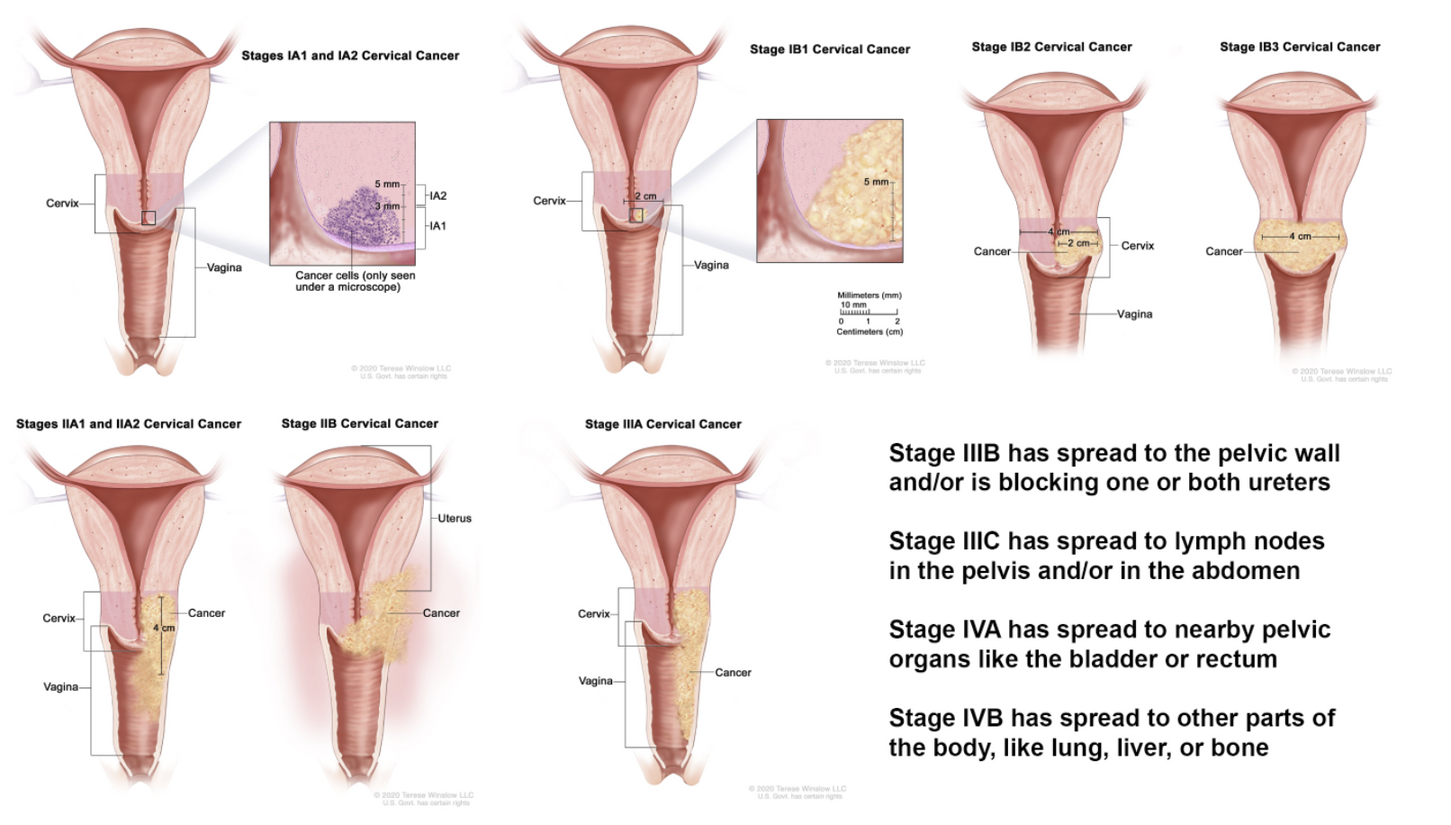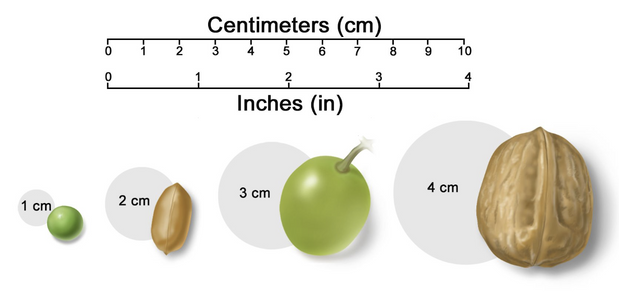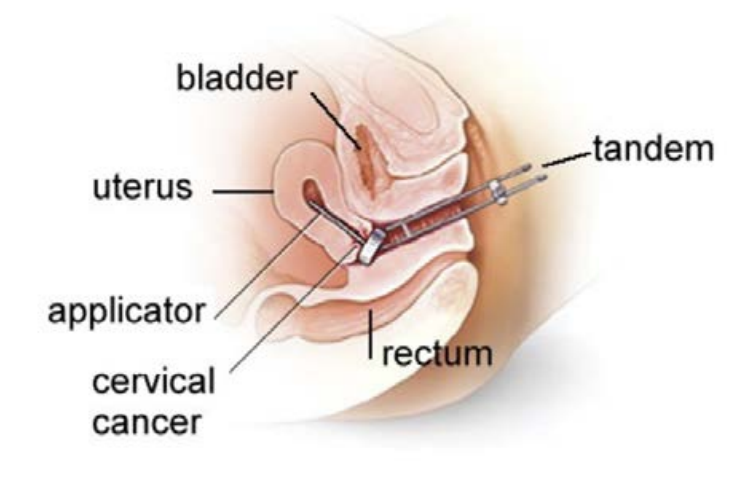
Cervical Cancer
BrachyTherapy
Tandem &
ring
Scroll down
Information about the treatment and what to expect
Cervical Cancer
Cervical cancer affects over 11,000 American women each year.
The cervix is the opening to the uterus (womb). Pap smears test the cervix for any abnormal cells. Abnormal cells can turn into cancer cells that start growing and spreading into nearby tissues.
The Uterus and Stages of Cervical Cancer
Click the infographic for more information from the National Cancer Institute

Treatment options for cervical cancer include surgery, chemotherapy, external beam radiation therapy, and brachytherapy.
Focused treatment with brachytherapy works well for cervical cancers.
Click each image for more information on that treatment type
What is brachytherapy?
Brachytherapy is a type of internal radiation used to treat cervical cancer. The radiation is delivered in the form of a seed, about the size of a grain of rice. The seed is inserted directly into the body and placed into or next to the tumor to target the cancer.
Brachytherapy can be used alone or in combination with other treatments such as external beam radiation therapy, surgery, or chemotherapy.
Brachytherapy may also be referred to as high dose rate (HDR) radiation.
Click on the images for more information on brachytherapy
Why use brachytherapy for cervical cancer?
Brachytherapy allows for effective treatment of cervical cancer. Because brachytherapy treats within a few centimeters from the source, it allows for the cancer to be treated with high doses while limiting radiation exposure to the surrounding healthy tissue. The decreased exposure to the surrounding tissue lowers the risk of side effects.
It is important to note that treatment for cervical cancer is not a one-size-fits-all scenario. There are many factors that influence your treatment and your doctor will create an individual plan that best suits you.

Where does the radiation come from?

Image of a common brachytherapy afterloader
The radiation source used for brachytherapy treatments comes in the form of a seed. The seed is stored in a unit called an afterloader, where it remains until it is time to be delivered for treatment.
Image comparing the size of a seed to a dime
How is the radiation delivered?
The afterloader has attachments called transfer tubes and an applicator. The applicator is inserted into your cervix. When it is time for treatment, the radiation seed travels through the tube and to the applicator. The radiation from the seed is released through the applicator to treat the tumor.

An applicator is a device designed to hold and deliver radiation. Tandem and ring applicators are used in cervical cancer treatments.
What is a tandem and ring?
A tandem and ring is a type of applicator used for cervical cancer. An applicator is a device used to guide the radiation used to treat gynecological cancers. The tandem and ring applicator offers a wide range of sizes and allows for adjustments to be made specifically to your anatomy.

Ring: This portion sits against your cervix
Tandem: This portion is inserted into your uterus

What to Expect During Brachytherapy Treatment
01
Sedation
Sedation options range from being completely awake (conscious sedation) to completely asleep (anesthesia) during the treatment procedure. This varies at each clinic.
02
Placement
You will be on your back with your knees up and legs apart, similar to a pelvic exam. You will be covered as much as possible. The radiation oncology doctor will place the applicator.
03
Simulation
You will be taken to another area where you will get a CT scan to check the applicator position. This scan is used to create your treatment plan.
04
Treatment Delivery
After your plan is created, you will be taken to the treatment room. A team of healthcare professionals will work together to deliver your treatment.
Normal Side Effects
Fatigue: you may feel tired for the rest of the day.
Vaginal irritation: you may feel sore or uncomfortable in the area that was treated. You can take extra-strength Tylenol and sit in a warm bath or use a sitz bath.
Vaginal discharge: you may experience a small amount of blood or have discharge with a pinkish tint. This can occur for 1 to 2 days after treatment. You can wear a pad, but avoid using tampons.
Click on the image for more information on common side effects from the National Cancer Institute
Less Common Side Effects
The following side effects are less common and can appear weeks after treatment.
Rectal irritation: you may experience diarrhea or feel pressure when using the bathroom.
Vaginal dryness: you may experience some irritation in the vaginal area.
Urinary problems: you may feel pressure or soreness when using the bathroom.
Vaginal stenosis: you may experience pain during intercourse. Vaginal stenosis is when the vagina becomes more narrow or shorter after treatment.
When should I call the doctor?
If you see any of these signs, please call your doctor for information on what to do next.
Painful or bloody stools
Blood in urine
Painful or burning urination
Swelling of the legs
Frequently Asked Questions
Will I be radioactive?
No, you will not be radioactive with HDR brachytherapy treatment.
The only time radiation is present is in the brachytherapy suite when the device is attached to the machine. After the treatment is complete, there is no radiation present in the room. There is no risk for you to be around family, children, or pregnant people.
How many treatments will I get?
Typically patients will have 3 to 5 separate procedures with or without anesthesia. The first appointment is usually the longest. The number of appointments will be decided by your oncology team.
Can I eat before and after?
A "low residue" diet may be recommended a few days prior to the procedure. If the procedure is under the use of a general anesthetic, you will need to fast starting at midnight the night before the procedure. This means no food or drinks, including coffee and breakfast.
Can I drive myself?
No, you should not drive yourself. It is best to have someone drive you to and from these appointments.
Can I take my normal medications?
Maybe. Please review your medications with your doctor and nurse before the procedure. They may ask you to stop some medications for the procedure.
Local Oregon Resources
Salem Health Cancer Institute
Gynecologic cancer support group
Breast and Cervical Cancer Treatment Program
This group is currently meeting in-person and virutally. Please email facilitator Melanie Berry for information. Meet with other women facing a gynecologic cancer to share and receive support.
OHP treatment coverage for people without insurance.
Thanks for visiting!
This website was created by OHSU Radiation Therapy Students. The information for this site was gathered from the references listed below. Content was approved by OHSU faculty. This information is meant for educational purposes only and should not replace the advice of a qualified medical professional.
References
American Cancer Society. (2020, January 20). Cervical cancer radiation therapy: Cervical cancer radiation treatment. Cervical Cancer Radiation Therapy | Cervical Cancer Radiation Treatment | American Cancer Society. https://www.cancer.org/cancer/cervical-cancer/treating/radiation.html#:~:text=Brachytherapy%20(internal%20radiation%20therapy),is%20known%20as%20intracavitary%20brachytherapy
Boothe, D., Hopkins, Z., Frandsen, J., & Lloyd, S. (2016, August). Comparison of external beam radiation and brachytherapy to external beam radiation alone for unresectable extrahepatic cholangiocarcinoma. Journal of gastrointestinal oncology. https://www.ncbi.nlm.nih.gov/pmc/articles/PMC4963367/
Brachytherapy for cancer. National Cancer Institute. (2019, January 29). https://www.cancer.gov/about-cancer/treatment/types/radiation-therapy/brachytherapy
Brachytherapy for cervix cancer treatment. Targeting Cancer. (n.d.). https://www.targetingcancer.com.au/radiation-therapy/brachytherapy/brachytherapy-for-cervix-cancer/
Cervical cancer treatment. Radiologyinfo.org. (n.d.). https://www.radiologyinfo.org/en/info/cervical-cancer-therapy







